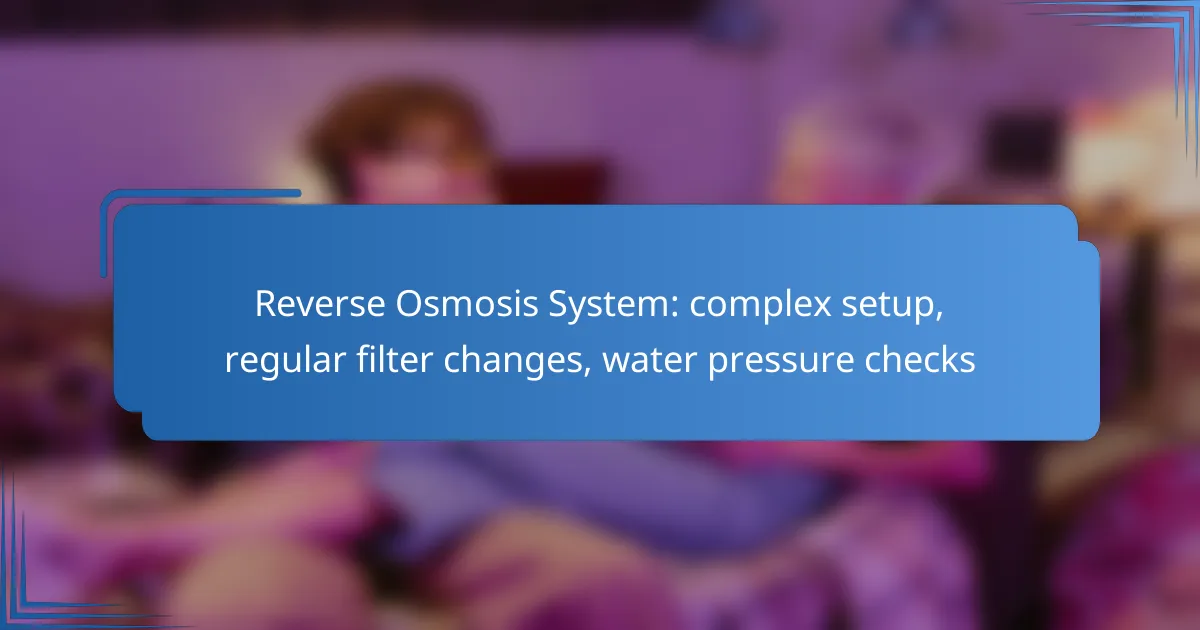A reverse osmosis system is designed to purify water by connecting multiple filters that eliminate impurities from your supply. To ensure the system operates effectively, it is essential to perform regular filter changes, typically every 6 to 12 months, based on usage and water quality. Additionally, monitoring the water pressure at the inlet is crucial for maintaining optimal performance and efficiency of the system.

How to set up a Reverse Osmosis System?
Setting up a reverse osmosis system involves connecting a series of filters to your water supply to remove impurities. Proper installation ensures optimal performance and longevity of the system.
Step-by-step installation guide
Begin by selecting a suitable location under your sink or in a utility area where the system can be easily accessed. Shut off the water supply and drain the existing plumbing to prevent leaks during installation.
Next, install the pre-filter and post-filter cartridges into the designated housing. Connect the RO membrane and attach the storage tank, ensuring all fittings are secure. Finally, connect the system to the water supply and check for leaks before turning the water back on.
Required tools and materials
To install a reverse osmosis system, you will need basic plumbing tools such as a wrench, screwdriver, and utility knife. Additionally, gather the following materials: the reverse osmosis system kit, a water supply adapter, and Teflon tape for sealing connections.
Having a bucket handy to catch any residual water during installation can also be helpful. Make sure to read the manufacturer’s instructions for any specific tools or materials they recommend.
Common installation mistakes
One common mistake is failing to check for leaks after installation. Always inspect all connections and fittings before using the system to avoid water damage. Another issue is improper placement of the filters, which can lead to reduced efficiency.
Additionally, neglecting to flush the system before first use can result in poor water quality. Follow the manufacturer’s guidelines for flushing to ensure the system operates correctly from the start.
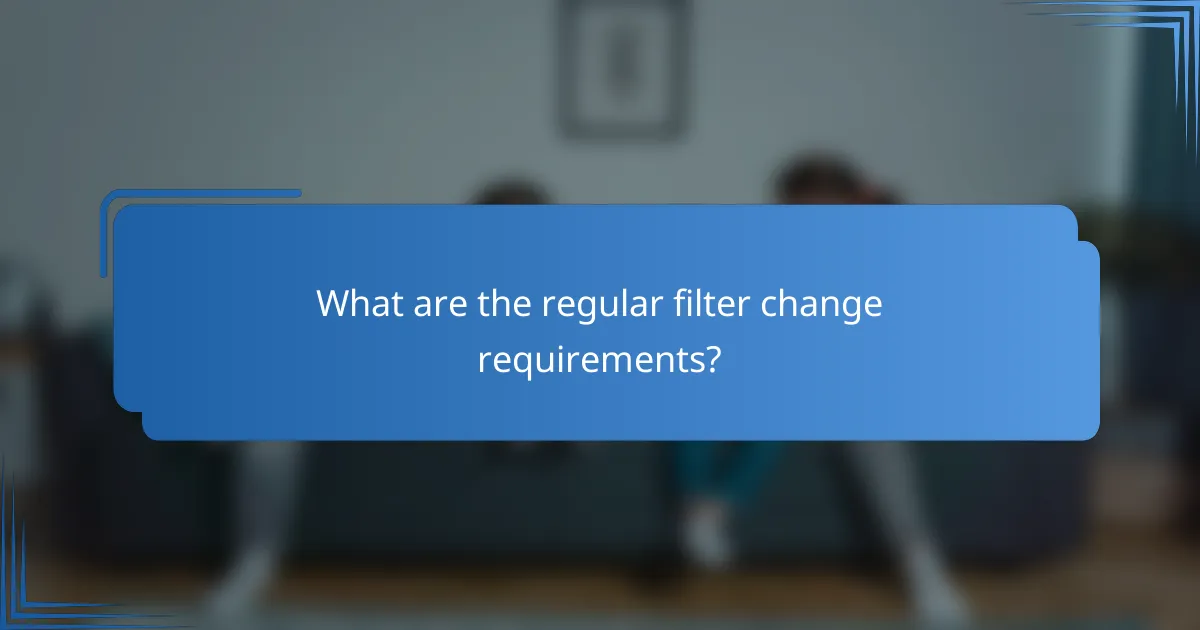
What are the regular filter change requirements?
Regular filter changes are essential for maintaining the efficiency and effectiveness of a reverse osmosis system. Typically, filters should be replaced every 6 to 12 months, depending on usage and water quality.
Filter types and lifespan
Reverse osmosis systems generally use three main types of filters: sediment filters, carbon filters, and the RO membrane. Sediment filters usually last around 6 to 12 months, while carbon filters may need replacement every 6 to 12 months as well. The RO membrane has a longer lifespan, often lasting 2 to 3 years, but this can vary based on water quality.
Understanding the specific lifespan of each filter type helps ensure optimal performance. Regular monitoring of filter conditions can prevent issues related to water quality.
Signs that filters need replacement
Common signs that filters need replacement include a noticeable decrease in water pressure, unusual tastes or odors in the water, and discoloration. If you observe any of these symptoms, it’s advisable to check the filters immediately.
Additionally, if the system produces a slower flow rate than usual, this can indicate that the filters are clogged and require changing. Regularly testing the water quality can also help identify when filters need to be replaced.
How to change filters
Changing filters in a reverse osmosis system typically involves a few straightforward steps. First, turn off the water supply and relieve pressure by opening the faucet. Then, remove the filter housing using a wrench if necessary, and take out the old filter.
Install the new filter by placing it in the housing and reassembling the unit. Make sure to tighten the housing securely to prevent leaks. Finally, turn the water supply back on and check for any leaks before allowing the system to run for a few hours to flush out any residual contaminants.

How to check water pressure for a Reverse Osmosis System?
To check water pressure for a Reverse Osmosis (RO) system, you need to measure the pressure at the inlet where water enters the system. Maintaining the correct water pressure is crucial for optimal system performance and efficiency.
Ideal water pressure range
The ideal water pressure for a Reverse Osmosis system typically falls between 40 to 60 psi (pounds per square inch). Pressures below this range can lead to inefficient filtration, while pressures above may cause damage to the system components.
Regularly monitoring your water pressure ensures that your RO system operates effectively, providing clean and safe drinking water. If your pressure is consistently outside this range, consider adjustments or professional evaluation.
Tools for measuring water pressure
To measure water pressure, you can use a pressure gauge, which is a simple device that attaches to a faucet or a hose bib. Many gauges are available at hardware stores and are relatively inexpensive.
Digital pressure gauges provide easy reading and can store measurements for future reference. Ensure the gauge is rated for the pressure range you expect to measure to avoid damage.
Adjusting water pressure settings
If your water pressure is outside the ideal range, you may need to adjust it. For systems with a pressure regulator, locate the adjustment screw and turn it to increase or decrease the pressure as needed.
In cases where the pressure is too low, check for clogs in filters or pipes that could be restricting flow. Conversely, if the pressure is too high, consider installing a pressure-reducing valve to protect your RO system from damage.
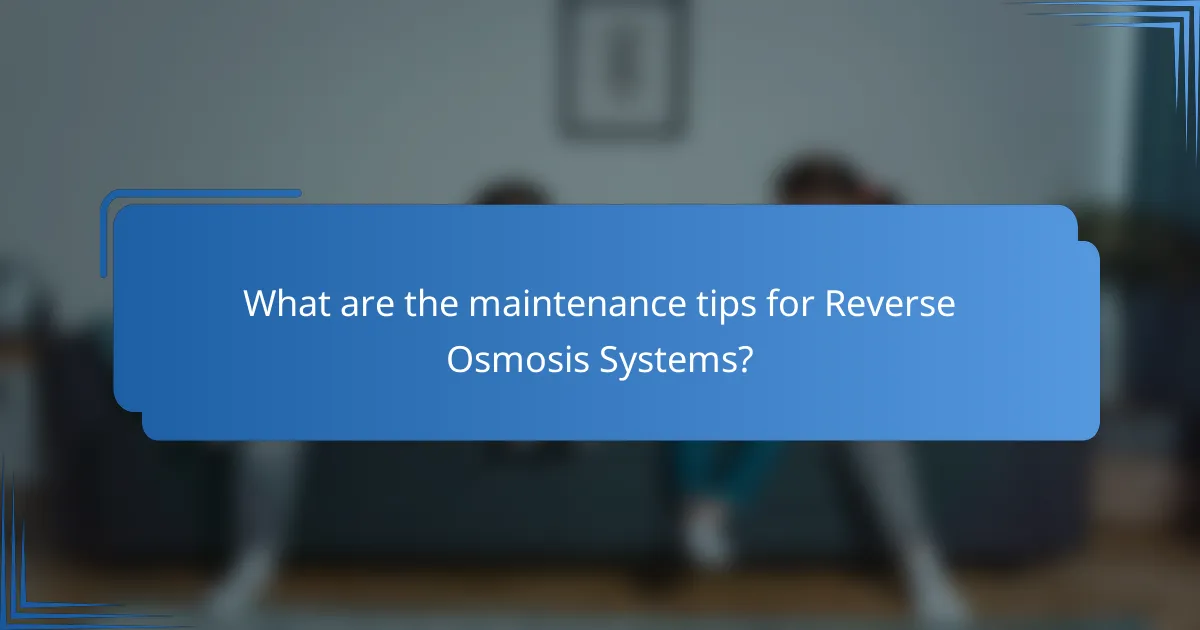
What are the maintenance tips for Reverse Osmosis Systems?
To ensure optimal performance of reverse osmosis systems, regular maintenance is essential. Key tasks include routine filter changes, monitoring water pressure, and checking for leaks or other issues.
Routine maintenance checklist
Establishing a routine maintenance checklist helps keep your reverse osmosis system functioning efficiently. Key tasks include:
- Change pre-filters and post-filters every 6 to 12 months, depending on water quality.
- Replace the reverse osmosis membrane every 2 to 5 years, based on usage and water conditions.
- Check water pressure regularly; optimal pressure typically ranges from 40 to 60 psi.
Additionally, inspect the system for leaks and ensure all connections are secure. Regularly sanitizing the system can also prevent bacterial growth.
Common issues and troubleshooting
Common issues with reverse osmosis systems include low water pressure, unusual tastes or odors, and leaks. If you notice low water flow, check the water pressure and filter condition first.
For strange tastes or odors, inspect the filters and membrane for contamination. Replacing these components often resolves the issue. If leaks occur, tighten connections and examine seals for wear.
Documenting maintenance activities and issues can help identify patterns and prevent future problems. Consider consulting the manufacturer’s guidelines for specific troubleshooting steps tailored to your model.
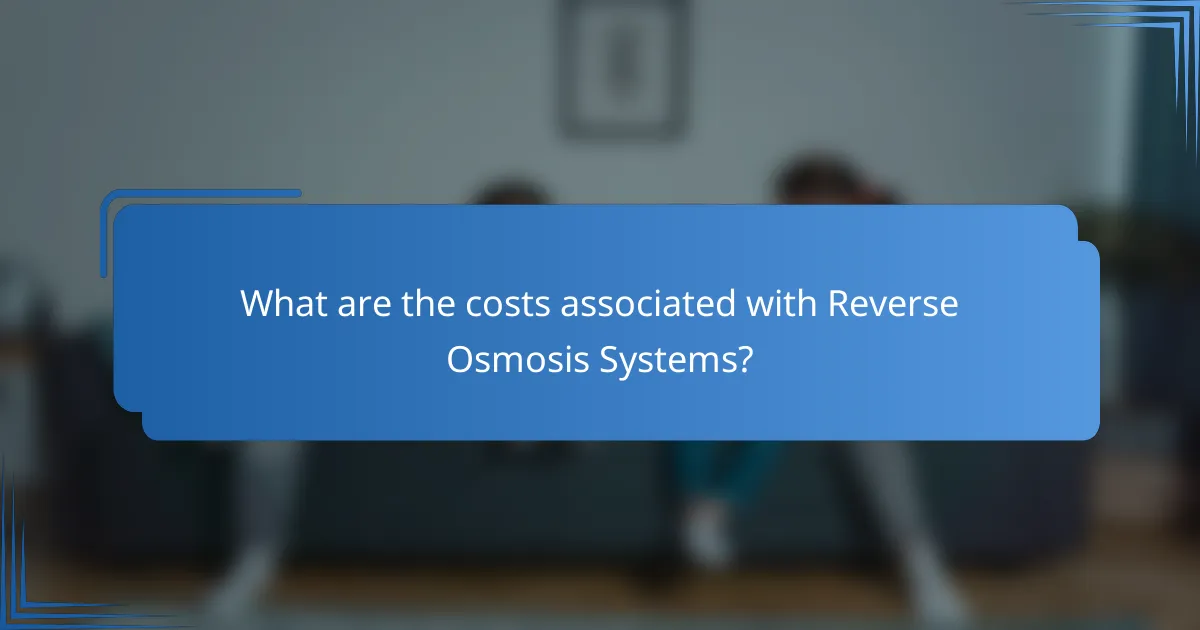
What are the costs associated with Reverse Osmosis Systems?
The costs associated with reverse osmosis systems include initial setup expenses and ongoing maintenance fees. Understanding these costs is crucial for budgeting and ensuring long-term efficiency of the system.
Initial setup costs
Initial setup costs for a reverse osmosis system can vary widely, typically ranging from a few hundred to over a thousand USD. Factors influencing these costs include the type of system (under-sink, whole house), brand, and installation complexity.
When considering installation, it’s important to factor in potential plumbing modifications, which may add to the overall expense. Hiring a professional installer can ensure proper setup, but DIY options are available for those with plumbing experience.
Ongoing maintenance expenses
Ongoing maintenance expenses for reverse osmosis systems primarily consist of regular filter changes and periodic system checks. Filter replacements usually occur every 6 to 12 months, costing between 50 to 150 USD, depending on the type and quality of filters used.
In addition to filter changes, it’s advisable to check water pressure and system performance regularly. Neglecting maintenance can lead to decreased efficiency and higher long-term costs due to potential repairs or replacements. Keeping a maintenance schedule can help manage these expenses effectively.
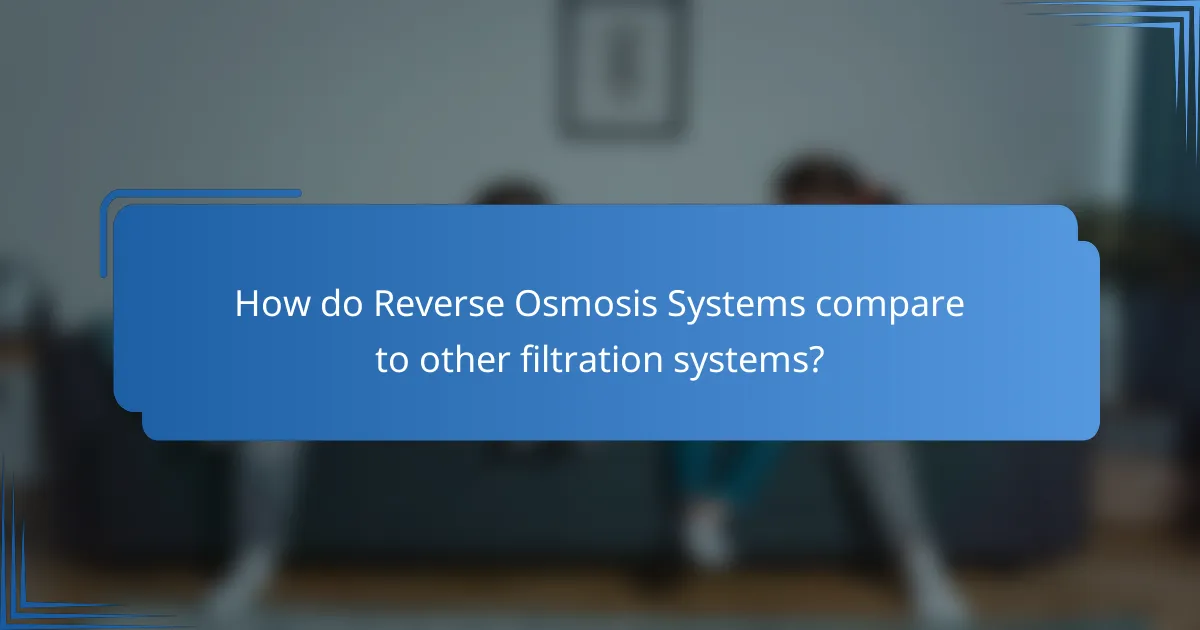
How do Reverse Osmosis Systems compare to other filtration systems?
Reverse osmosis (RO) systems are highly effective at removing contaminants from water, often outperforming other filtration methods in terms of purity. While they provide excellent filtration, they require more complex setups and regular maintenance compared to simpler systems.
Reverse Osmosis vs. Activated Carbon
Activated carbon filters are effective at removing chlorine, sediment, and volatile organic compounds, but they do not eliminate dissolved solids or certain heavy metals. In contrast, reverse osmosis systems can remove a broader range of contaminants, including salts and minerals, making them suitable for areas with hard water.
When considering which system to use, think about your specific water quality needs. If your primary concern is taste and odor, activated carbon may suffice. However, for comprehensive purification, especially in regions with high TDS (total dissolved solids), an RO system is preferable.
Reverse Osmosis vs. UV Filtration
Ultraviolet (UV) filtration systems excel at disinfecting water by killing bacteria and viruses but do not remove chemical contaminants or dissolved solids. Reverse osmosis systems, on the other hand, provide both disinfection and physical filtration, making them more versatile for overall water quality improvement.
For households concerned about microbial contamination, combining UV filtration with reverse osmosis can offer a robust solution. This dual approach ensures that both harmful microorganisms and chemical impurities are effectively addressed, providing safe drinking water.
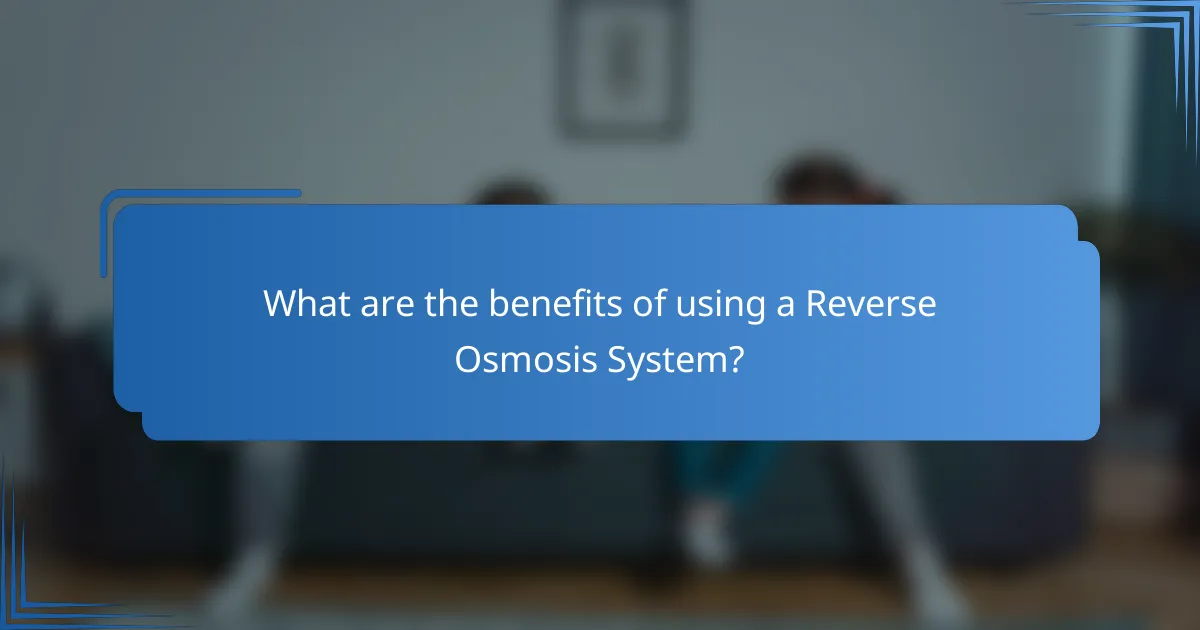
What are the benefits of using a Reverse Osmosis System?
A Reverse Osmosis (RO) system effectively removes impurities from water, providing cleaner and safer drinking water. Its benefits include improved taste, reduced contaminants, and enhanced overall water quality.
Improved water quality
Reverse Osmosis systems significantly enhance water quality by filtering out a wide range of contaminants, including heavy metals, chlorine, and bacteria. This process typically involves multiple stages of filtration, ensuring that the water is not only clear but also free from harmful substances.
Regular maintenance, such as changing filters every 6 to 12 months, is essential to maintain optimal performance. Neglecting this can lead to decreased filtration efficiency and potential recontamination of the water supply.
Health benefits of purified water
Drinking purified water from an RO system can lead to various health benefits. By removing contaminants, it helps reduce the risk of gastrointestinal diseases and other health issues associated with polluted water sources.
Moreover, purified water can improve hydration and overall wellness. It is particularly beneficial for sensitive populations, such as children and the elderly, who may be more susceptible to the effects of contaminants.
